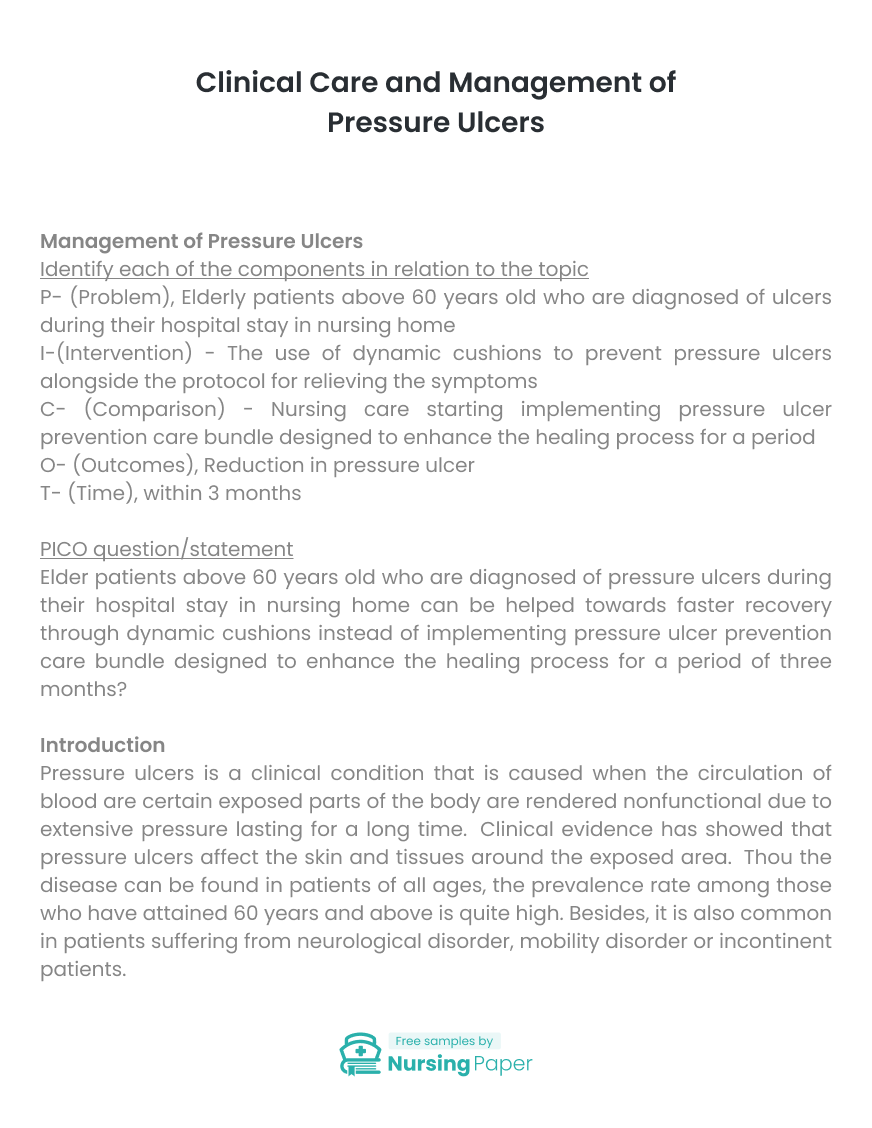
Clinical Care and Management of Pressure Ulcers
Management of Pressure Ulcers
Identify each of the components in relation to the topic
P- (Problem), Elderly patients above 60 years old who are diagnosed of ulcers during their hospital stay in nursing home
I-(Intervention) – The use of dynamic cushions to prevent pressure ulcers alongside the protocol for relieving the symptoms


C- (Comparison) – Nursing care starting implementing pressure ulcer prevention care bundle designed to enhance the healing process for a period
O- (Outcomes), Reduction in pressure ulcer
T- (Time), within 3 months

PICO question/statement
Elder patients above 60 years old who are diagnosed of pressure ulcers during their hospital stay in nursing home can be helped towards faster recovery through dynamic cushions instead of implementing pressure ulcer prevention care bundle designed to enhance the healing process for a period of three months?
Introduction
Pressure ulcers is a clinical condition that is caused when the circulation of blood are certain exposed parts of the body are rendered nonfunctional due to extensive pressure lasting for a long time. Clinical evidence has showed that pressure ulcers affect the skin and tissues around the exposed area. Thou the disease can be found in patients of all ages, the prevalence rate among those who have attained 60 years and above is quite high. Besides, it is also common in patients suffering from neurological disorder, mobility disorder or incontinent patients. According to Cassel and Walsh (2014), 78 percent of infections have been reported among patient of 60 years and above in the United States between 2015 and 2016. This has forced the government to look into alternative management and mitigation strategies.
The prevention of pressure ulcers is of significant priority in nursing care given the rate of high incidences and severe consequences they have on patients alongside the large cost that plunge the healthcare system into. Therefore, it is the responsibilities of nurses to play a role in the management of pressure ulcers. However, patients may also take part in care management of their illness. According to In Söderback (2015), patient participation has significantly contributed to patient safety and satisfaction with care. For instance, the use of dynamic cushions among elderly patients who have attained the age of 60 years and beyond seems to be a recommendable technique in care management. From time to time, team healthcare personnel’s including nurses, doctors and dieticians would work together towards care management of patients with pressure ulcers. However, evidence based for pressure ulcers is still not available. It is under this premise that the study resorted to explore the dynamic cushions can be used best in the management of pressure ulcers instead of care bundle designed to enhance the healing process for a period of three months.



Assessment and Management Guidelines
Patients associated with pressure ulcers are more likely to experience an extent of any existing damage on their skin. Therefore, it is important to consider individual episode care and develop a care plan to check on the patients regularly. Therefore, an assessment should always be undertaken at the time of admission and proper guidance be recommend to mitigate infection or rather reduce pain to the patients. According to Cherry and Jacob (2016), there is still lack of evidence based practices designed to manage pressure ulcers in a clinical care setting. Therefore, the use of dynamic cushions and care bundle going for a period of 3 months are both considered as alternatives.
1. Cassel, C. K., & Walsh, J. R. (2014). Geriatric Medicine: Volume II: Fundamentals of Geriatric Care. New York, NY: Springer New York.
2. In Söderback, I. (2015). International Handbook of Occupational Therapy Interventions. Cham, Switzerland : Springer Pub
3. Cherry, B., & Jacob, S. R. (2016). Contemporary nursing: Issues, trends, & management. Elsevier Health Sciences.



The download will start shortly.

The download will start shortly.
 Subject:
Nursing
Subject:
Nursing  Number of pages: 4
Number of pages: 4  Subject:
Nursing
Subject:
Nursing  Number of pages: 2
Number of pages: 2  Subject:
Nursing
Subject:
Nursing  Number of pages: 4
Number of pages: 4  Subject:
Nursing
Subject:
Nursing  Number of pages: 3
Number of pages: 3  Subject:
Nursing
Subject:
Nursing  Number of pages: 2
Number of pages: 2  Subject:
Medicine
Subject:
Medicine  Number of pages: 2
Number of pages: 2  Subject:
Nursing
Subject:
Nursing  Number of pages: 6
Number of pages: 6  Subject:
Medicine
Subject:
Medicine  Number of pages: 3
Number of pages: 3  Subject:
Health and Social Care
Subject:
Health and Social Care  Number of pages: 12
Number of pages: 12  Subject:
Health and Social Care
Subject:
Health and Social Care  Number of pages: 4
Number of pages: 4  Subject:
Nursing
Subject:
Nursing  Number of pages: 3
Number of pages: 3  Subject:
Health and Social Care
Subject:
Health and Social Care  Number of pages: 3
Number of pages: 3  Subject:
Nursing
Subject:
Nursing  Number of pages: 10
Number of pages: 10  Subject:
Health and Social Care
Subject:
Health and Social Care  Number of pages: 3
Number of pages: 3  Subject:
Health and Social Care
Subject:
Health and Social Care  Number of pages: 2
Number of pages: 2 
